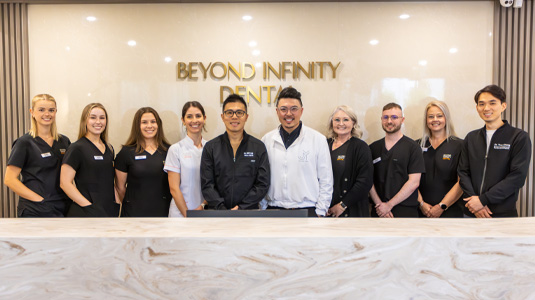Most people wish they could change one or more things about the appearance of their smile but worry that cosmetic dentistry may be painful, complicated, or look unnatural. Porcelain veneers offer a quick and easy cosmetic option that our dentist can complete in as little as two appointments at our dental clinic. This article will walk you through the veneers procedure, so you know what to expect at every stage. Let’s get started.
Process Of Porcelain Veneers – A Step-By-Step Guide
Step 1 – Consultation visit
Before starting the dental veneers process, you need to schedule a consultation appointment with our experienced cosmetic dentist, Dr Jack Yang. A thorough oral examination will be carried out during this appointment, checking your teeth and gums to determine if veneers are a suitable option for your oral health circumstances. Because porcelain veneers are so versatile, dentists recommend them to treat a wide range of cosmetic and dental imperfections, including teeth that are:
- Cracked
- Chipped
- Worn
- Misshapen
- Severely discoloured
- Crooked
 Customised to meet an individual’s unique needs and style, our cosmetic dental veneers provide a long-lasting smile that we know you will love.
Customised to meet an individual’s unique needs and style, our cosmetic dental veneers provide a long-lasting smile that we know you will love.
Veneers are wafer-thin porcelain shells applied to the teeth’ front surface to transform the smile immediately.
While a similar effect can be created with composite bonding, most patients prefer porcelain veneers for their durability and natural look.
Having been approved for the veneers procedure, the next stage in the process of porcelain veneers is for you and Dr Yang to design your new smile.
Step 2 – Smile design
We believe in involving patients in their dental veneers treatment from the get-go. We can show patients how their new smile will look thanks to innovative digital smile design software.
You don’t need to cover every tooth with a veneer, just the ones causing problems and possibly the neighbouring teeth. Many patients cover just the teeth in their smile line because they are the most visible. Sometimes our dentist can fit individual veneers into a person’s existing smile if it’s mostly how they want it – a bit like placing pieces into a jigsaw puzzle.
Dr Yang can make the best recommendation for how many veneers you require based on what you hope to achieve and match their shape and colour to the remaining natural teeth.
Step 3 – Smile preparation
Tooth preparation is the next stage in the process of porcelain veneers. While it is possible to prepare the teeth without anaesthetic, most patients find they need it. Cold water sprayed from the dentist’s drill and the suction device can make the teeth and some tissues feel sensitive.
With conventional porcelain veneers, our dentist will shave some of the enamel from the front side of the tooth by about the same amount as the thickness of the veneer it will be bonded to. This ensures the veneer remains flush with the smile and does not impact the patient’s bite. As far as possible, the level of trimming is limited to just the layer of tooth enamel, thus avoiding a tooth’s dentin layer.
Our dentist will use a shade guide to determine the colour of porcelain that’s the closest match to the teeth on either side of the tooth being veneered. Dr Yang excels at blending the colour of porcelain to create an exact shade that blends seamlessly into the smile. He can also bleach the remaining teeth to match the shade of the porcelain veneers if required.
Once tooth preparation is complete, the next stage of the veneers procedure is digitally scanning the teeth and surrounding tissues to create impressions used to fabricate your bespoke custom veneers.
The impressions are sent to the dental lab making the porcelain veneers and may take a couple of weeks to complete.
Most patients are fitted with temporary dental veneers to protect the prepared teeth.
Step 4 – Pre-cementation evaluation
We’re now nearing the end of the process of porcelain veneers. At this point, you have returned to the dental clinic and had your temporary veneers removed. Your permanent porcelain veneers are back from the lab and ready to be bonded to your teeth.
But first, there are a few elements of the process your dentist needs to evaluate. 
- Fit – Before bonding your veneers, the dentist will try them on your teeth to check how they fit. They will be set in place, inspected, removed and trimmed repeatedly until the dentist is satisfied with their fit.
- Shape – Even though the technician has crafted the porcelain veneers to what they consider the perfect shape, our dentist may think otherwise. Certain edges may have to be rounded, squared or trimmed to look right, and the dentist will do this.
- Colour – If a patient isn’t happy with the colour of their veneers, the dentist can use try-in pastes until the right colour is found. This is the last chance to change the colour, as once the veneers are bonded, they can’t be changed.
Once both parties are happy, it’s finally time to bond the porcelain veneers to the teeth. Acid etching gel is applied to create a rough enamel surface that helps the veneers to adhere. A special curing light is shone, setting the bonding in around one minute.
All that’s left in the veneers procedure is to look in the mirror and admire your beautiful new smile.
Get your new smile here
Now you know the process of porcelain veneers, why not schedule a free consultation with the team at Beyond Infinity Dental?
We want the best results for our patients, which is why we use Infinity Lumineers. This ground-breaking innovation has resolved many issues associated with porcelain veneers, namely staining and discolouration. With a unique blend of porcelain adhesive and cement, your thin veneers will remain colour-stable for their life. Call us on (02) 8806 3799 or book online and take the first step to a gorgeous new smile.
Note: Any surgical or invasive procedure carries risks. Before proceeding, you should seek a second opinion from an appropriately qualified health practitioner.
References
PubMed Central – Digital Smile Design – An innovative tool in aesthetic dentistry
https://www.ncbi.nlm.nih.gov/pmc/articles/PMC7193250
PubMed Central – Color agreement between try-in paste and resin cement
https://www.ncbi.nlm.nih.gov/pmc/articles/PMC6571517/









